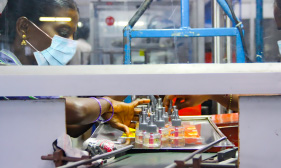Risks and
Opportunities
We have a comprehensive and structured approach to risk management at GCPL. Across our geographies, we have integrated the way we manage risk into the operating framework and reporting channels of our business. Starting with Board-level oversight to a dedicated Risk Committee, a cross-functional team within the business, we routinely assess risks across the company and all geographies. We have a risk management team as part of the Corporate Audit function that engages in discussions with various functional heads and relevant team members to identify potential risks, assess the business impact, and rate the likelihood of occurrence.
The identified risks are routinely discussed with the GCPL Management Committee and progress updates are presented to the Risk Management Committee of the GCPL Board, which meets on a half-yearly basis. A cross-functional team also operates at the Godrej Industries Group level to identify potential risks and mitigate the same across businesses. Further, employees keep sharing their perception of potential risks via informal forums, discussions, and annual planning conferences. We are also looking at creating a platform for the employees to share their perception on potential risks. Last year, we introduced a mobile app to identify potential safety-related risks.
Employees are routinely encouraged to provide feedback for continuous improvement in risk management practices. An annual InTune survey is conducted across the company seeking suggestions and feedback from all the employees. Also, there are regular open forums and monthly review meetings conducted to understand the emerging risks and develop mitigation measures. Valid risks identified by the team members are recorded by the line manager and communicated to the Management Committee for further action.
Training sessions on Enterprise Risk Management are organised throughout the year for employees at all levels. Inputs on risk definition, risk identification, risk rating, risk classification, risk prioritisation, risk mitigation, control, and review are imparted to participants. Workshops on crisis management were also conducted across all manufacturing facilities during the fiscal year. The risk assessment process is aligned to regional and global risks as identified by the World Economic Forum. These risks, along with the mitigation plan and opportunities, are listed below.
Risks and Opportunities
| Risks | Opportunities | Strategic Pillar Alignment |
|---|---|---|
|
Compliance and regulatory changes and emerging regulations |
We ensure the highest levels of statutory compliance and ensure that all regulations and laws of the land are adhered to. GCPL has an internal system called Legatrix, which helps all manufacturing units monitor adherence to compliance and regulations. It enables management with a one-stop view of the organisation’s compliances and control mechanism through comprehensive compliance dashboards and provides necessary information at the operating level by creating a comprehensive matrix on laws and their management. Further, our Legal and Audit teams are in constant communication with key government departments and industry bodies to keep track of new and emerging regulations. They routinely assess and analyse regulations to mitigate business risk. |
|
|
Supply chain risks related to the following:
|
Our focus in manufacturing and supply chain is on becoming future-ready. We have initiated projects in Industry 4.0 and are making future-ready investments to ramp up our processes. We have seen encouraging results in improved productivity, greater accuracy, safety, and efficiency. We continue to introduce best practices across geographies and are trying to become more agile in responding to constantly changing consumer needs. Core to our approach is how we build win-win relationships with all our partners, collaborating closely to ensure capability development and alignment with our core values. Our ongoing engagement with partners has helped us identify emerging issues and adequately respond to them in time. |
|
|
Environmental risks and dependence on natural resources |
We have always actively championed social and environmental responsibility. As part of our Good & Green vision, we have 6 environmental sustainability goals to be achieved by fiscal year 2025-26. We have made good progress against these goals and have analysed areas where we need to ramp up our efforts in the future. We actively identify and adopt new green technology that helps us reduce usage, reuse, recycle, and adopt circularity. |
|
|
Competitive risks:
|
We have centered our growth strategy around emerging markets and the emergent consuming class in them. As incomes rise, purchasing power improves and these markets mature; new distribution systems and the digital economy are enabling greater reach. To be able to leverage this, we are ramping up our go-to-market and digital strategies and reach to go deeper and improve penetration. We are also the leaders in most categories in the markets we operate in and are constantly innovating to create more superior quality products at affordable prices. |
|
|
Political economy in geographies of operation:
|
Our focus is to build leadership in Home Care and Personal Care in 3 emerging geographies: Asia, Africa, and Latin America. Our Risk Committee, along with regional Business and Finance teams, closely monitors the political economy of each geography to respond and adapt to emerging situations. Our globalisation strategy has been very deliberate and guided by this, over the last decade, we have created significant value through M&A and established strong beachheads. |
|
|
Labour risks due to the following:
|
At GCPL, we have a capable, engaged, and productive workforce and the company is committed to ensuring their well-being. Our activities and investments in attracting and retaining talent, providing a safe, healthy and engaged working environment, promoting employee training and development, ensuring fair labour and contracting practices, and encouraging local employment opportunities provide the foundation for optimising value creation. Through our comprehensive COVID-19 relief initiatives, we implemented wide-ranging protective measures and adapted our operations to a new way of working amidst the pandemic. |
|
|
Social risks arising from the following:
|
We are now exploring ways to further this commitment through shared value initiatives that create value for both society and business. Our business continuity plans are in place to address any man-made or natural disasters and ensure business as usual. |
|
|
Cyber security: We depend on information systems and technology, including public websites and cloud-based services, for many activities important to our business, including communications within our company, and interfacing with customers and consumers. Some of the threats facing our business are as follows:
|
Mitigation measures comprise performing periodic risk assessment and mitigation, including threat analysis and vulnerability assessments. Our teams control, monitor, and log all access to protected assets. We have defined and enforced secure change control and configuration management processes, and are working towards training employees in incident-handling and contingency plans. Further mitigation measures include advanced web security, perimeter intrusion prevention, perimeter firewalls, application firewalls, internal firewalls, and advanced server security. |
|
In addition to the risks identified by the Committee and by our team members, the fiscal year 2019-20 materiality study also pointed out issues which form a critical input to our formal risk criticality matrix. The material issues identified ultimately connect to broad risk drivers.
The risk assessment process is aligned to regional and global risks as identified by the World Economic Forum. These risks, along with the mitigation plan and opportunities, are listed below.
Top material issues and associated
business risks
| Top material issues and associated business risks | Opportunities | Alignment with strategic pillars |
|---|---|---|
|
Sustainable packaging: Increasing public awareness about environmental concerns has resulted in higher demand for sustainable packaging and processing operations. GCPL is already working to reduce plastic waste by creating thinner and lighter packaging and reducing waste. Risks associated with sustainable packaging:
|
GCPL believes that in order to develop an optimum sustainable packaging solution for any product, there is a need for three distinct considerations:
A few of our mitigation efforts in this regard include:
|
|
|
R&D: R&D is critical to the growth and prosperity of our business. The risks associated with this function are as follows:
|
A two-pronged approach to innovation, including democratisation and creating new vectors of growth.
|
|
|
Responsible marketing and communication: Social and responsible marketing practices are becoming the norm, where companies acknowledge the larger social and environmental impacts of their products and services and/or adopt a specific social or environmental stance which resonates with their brand image. Associated risks include:
|
We adhere to the norms of the Advertising Standards Council of India and those of other local bodies in our international geographies as the basis for all our communications. All our marketing and advertising is in line with the expectations of these bodies, that is, ‘legal, decent, honest, and truthful’, and we ensure that all the claims we make have a scientific basis. |
|
|
Building inclusive and prosperous communities: It is generally believed that CSR is a way of managing and reducing risk. But, in addition to its possible benefits, CSR also creates risks:
|
|
|
|
Governance and accountability: GCPL’s sustainability governance aims to ensure the company’s commitments to its stakeholder groups with regard to its aim to create an inclusive and greener world. |
It is increasingly important for corporate boards to understand how these issues affect business strategy and performance. Impacts from these issues can be financial and material, and can be spread across multiple areas of a business.
|
|
|
Occupational health and safety:
|
This is a high priority area for GCPL. We have a dedicated Human Rights Policy, strong SOPs to ensure the highest adherence to health and safety, and a governance mechanism to ensure any incidents are duly investigated and resolved for the future. |
|
|
Training and skill development: At GCPL, we believe that learning is a continuous process and happens on the job through a combination of challenging assignments and a variety of roles. Some risks associated with this aspect include:
|
|
|






